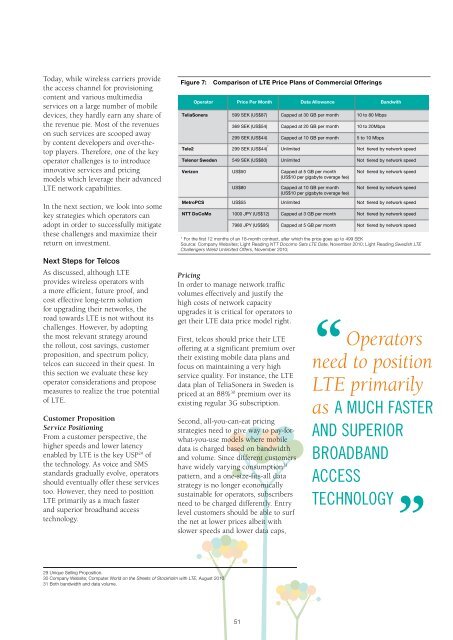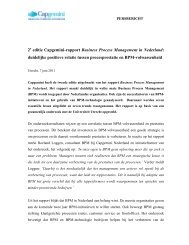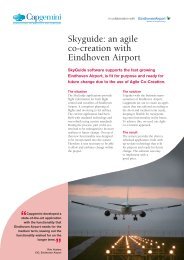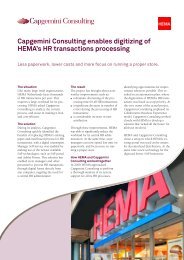IT transformations - Capgemini Consulting Nederland
IT transformations - Capgemini Consulting Nederland
IT transformations - Capgemini Consulting Nederland
You also want an ePaper? Increase the reach of your titles
YUMPU automatically turns print PDFs into web optimized ePapers that Google loves.
Today, while wireless carriers provide<br />
the access channel for provisioning<br />
content and various multimedia<br />
services on a large number of mobile<br />
devices, they hardly earn any share of<br />
the revenue pie. Most of the revenues<br />
on such services are scooped away<br />
by content developers and over-thetop<br />
players. Therefore, one of the key<br />
operator challenges is to introduce<br />
innovative services and pricing<br />
models which leverage their advanced<br />
LTE network capabilities.<br />
In the next section, we look into some<br />
key strategies which operators can<br />
adopt in order to successfully mitigate<br />
these challenges and maximize their<br />
return on investment.<br />
Next Steps for Telcos<br />
As discussed, although LTE<br />
provides wireless operators with<br />
a more efficient, future proof, and<br />
cost effective long-term solution<br />
for upgrading their networks, the<br />
road towards LTE is not without its<br />
challenges. However, by adopting<br />
the most relevant strategy around<br />
the rollout, cost savings, customer<br />
proposition, and spectrum policy,<br />
telcos can succeed in their quest. In<br />
this section we evaluate these key<br />
operator considerations and propose<br />
measures to realize the true potential<br />
of LTE.<br />
Customer Proposition<br />
Service Positioning<br />
From a customer perspective, the<br />
higher speeds and lower latency<br />
enabled by LTE is the key USP 29 of<br />
the technology. As voice and SMS<br />
standards gradually evolve, operators<br />
should eventually offer these services<br />
too. However, they need to position<br />
LTE primarily as a much faster<br />
and superior broadband access<br />
technology.<br />
Figure 7:<br />
Comparison of LTE Price Plans of Commercial Offerings<br />
Operator Price Per Month Data Allowance Bandwith<br />
TeliaSonera 599 SEK (US$87) Capped at 30 GB per month 10 to 80 Mbps<br />
369 SEK (US$54) Capped at 20 GB per month 10 to 20Mbps<br />
299 SEK (US$44) Capped at 10 GB per month 5 to 10 Mbps<br />
Tele2 299 SEK (US$44) * Unlimited Not tiered by network speed<br />
Telenor Sweden 549 SEK (US$80) Unlimited Not tiered by network speed<br />
Verizon US$50 Capped at 5 GB per month<br />
(US$10 per gigabyte overage fee)<br />
US$80<br />
Capped at 10 GB per month<br />
(US$10 per gigabyte overage fee)<br />
Not tiered by network speed<br />
Not tiered by network speed<br />
MetroPCS US$55 Unlimited Not tiered by network speed<br />
NTT DoCoMo 1000 JPY (US$12) Capped at 3 GB per month Not tiered by network speed<br />
7980 JPY (US$95) Capped at 5 GB per month Not tiered by network speed<br />
* For the first 12 months of an 18-month contract, after which the price goes up to 499 SEK<br />
Source: Company Websites; Light Reading NTT Docomo Sets LTE Date, November 2010; Light Reading Swedish LTE<br />
Challengers Wield Unlimited Offers, November 2010;<br />
Pricing<br />
In order to manage network traffic<br />
volumes effectively and justify the<br />
high costs of network capacity<br />
upgrades it is critical for operators to<br />
get their LTE data price model right.<br />
First, telcos should price their LTE<br />
offering at a significant premium over<br />
their existing mobile data plans and<br />
focus on maintaining a very high<br />
service quality. For instance, the LTE<br />
data plan of TeliaSonera in Sweden is<br />
priced at an 88% 30 premium over its<br />
existing regular 3G subscription.<br />
Second, all-you-can-eat pricing<br />
strategies need to give way to pay-forwhat-you-use<br />
models where mobile<br />
data is charged based on bandwidth<br />
and volume. Since different customers<br />
have widely varying consumption 31<br />
pattern, and a one-size-fits-all data<br />
strategy is no longer economically<br />
sustainable for operators, subscribers<br />
need to be charged differently. Entry<br />
level customers should be able to surf<br />
the net at lower prices albeit with<br />
slower speeds and lower data caps,<br />
“<br />
Operators<br />
need to position<br />
LTE primarily<br />
as a much faster<br />
and superior<br />
broadband<br />
access<br />
technology<br />
”<br />
29 Unique Selling Proposition.<br />
30 Company Website; Computer World on the Streets of Stockholm with LTE, August 2010.<br />
31 Both bandwidth and data volume.<br />
51
















